2023 SciUS Symposium at Thammaast Univ. (SciUSシンポジウム,page 2)
Silpakorn University (シルパコーン大学,Page 3)
Mahidol University Kanchanarubi Campus and Field Trip (マヒドン大学カンチャナブリキャンパスほか,Page 4)
Chiang Mai University (チェンマイ大学,Page 5)
Phayao University (パヤオ大学,Page 6)
Extra Note: Bangkok Downtown and Cambodia trip(余録:バンコク下町風景とカンボジア旅行,Page 7)
Mahidol University Kanchanarubi Campus and Field Trip (マヒドン大学カンチャナブリキャンパスほか,Page 4)
Face Bookの次の2つの記事をまとめて,修正追加のうえ,Webサイトに上げます.
<カンチャナブリ日記1日目>現在次の訪問先ChaingMai大学に向けて出発まちです.こちらの大学のバンで送ってもらう時刻まで,この日記を綴りま す.ナコンパトムにあるSilpakorn 大学は元々芸術系の大学としてスタートし,その後次々と学部を創設して現在に至っています.https://www.bestscope.net/bs-3010a-stereo-microscope/
2023.11-05.クワイ河(クウェー川)橋に関する補足.下記の動画にこの橋および鉄道建設に関する資料が数多く紹介されています.
https://www.youtube.com/watch?v=WL5k45jc7QI
The following two articles from Face Book will be uploaded to the web site after some modifications and additions.
<Kanchanaburi visit> I am now on my way to my next destination, Chaing Mai University. I will write this diary until the time when I will be dropped off by the university's van. Silpakorn University in Nakhon Pathom originally started as a university of arts, and then established several faculties. https://www.bestscope.net/bs-3010a-stereo-microscope/
During the last two days of my stay, I went on a two day/night field trip to a geological site in the central part of Kanchanaburi Province, including a visit to a geological museum and outcrops around a large dam lake and a waterfall climb. On the second day, yesterday, we visited the geological museum, related geosites and fossil outcrops at the Faculty of Geoscience, Mahidol University, where we stayed, and observed the famous tourist attraction, the "Kwai River Bridge". This page shows pictures of the first day of the tour, and since many of my FB friends are geology experts, I will show more geology pictures later.
 |
 |
| こ
れはカンチャナブリに近づいた国道沿いには,大変多くの石材屋がありました.庭石などの加工をしているようですが,カンチャナブリは石灰岩を中心とし,砂
岩(Quarzite),チャート及び貫入岩などその多様な地質でも有名です.5年前にKVIS(タイの科学高校)に居たときに,カンボジアとの国境近く
のサファイヤ鉱山を訪ねたことがあるのですが,そちらはチャンタブリで未だによく間違えます.そのときの訪問記はこちらです.http://yossi-okamoto.net/KVIS/2017/Photo_diary_Part3.html
There
are many stone dealers along the national highway approaching
Kanchanaburi. Kanchanaburi is famous for its diverse geology, which
includes limestone, sandstone (quartzite), chert and intrusive rocks. I still often make the mistake of calling it Chanthabur, where I visited a sapphire mine near the Cambodian border five years ago when I was at KVIS (Thai science high school). i. Here is the account of that visit: http://yossi-okamoto.net/KVIS/2017/Photo_diary_Part3.html |
さ
て,カンチャナブリの市内を迂回するバイパスのパーキングエリアから東側の山を観た景色.屹立する一連の崖はあとで調べると,ほとんどが古生代の石灰岩,
ないしドロマイト(CaMgCO3)だということがわかりました.行ったことはないのですが,米国西部のグランドキャニオンでも屹立する崖は石灰岩だと聞
いたことがあります.
This is a view of the mountains to the east from a highway parking area bypassing the city of Kanchanaburi. Later I found out that most of the towering cliffs are made of Paleozoic limestone or dolomite (CaMgCO3). I have never been to the Grand Canyon in the western United States, but I have heard that the soaring cliffs are also made of limestone. |
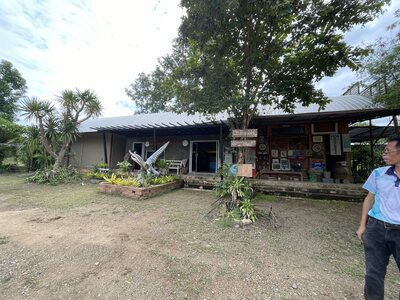 |
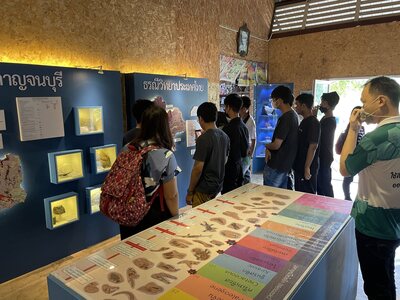 |
| さ
てここからさらに1時間ほどかけて北上すると,大きなダム湖があり,その周辺に小さな化石博物館がありました.これでも(と言っては失礼ながら)タイ地質
調査所(DMR)に属する博物館だそうです.大きな直角貝のモニュメントが我々を出向かえます.右の方はこの博物館のスタッフの方です.本当に目だない
ひっそりと建てられた博物館です
After about an hour's drive north from here, I found a large dam lake and a small fossil museum around it. This museum belongs to the Geological Survey of Thailand (DMR). A large monument of Orthoceras welcomes us. The person on the right is a staff member of this museum. It is a small local museum. |
建物の外観はさておき,内部の展示は立派なものばかりでした.この地域の地質の概要やら化石やらが,数多く展示されています.惜しむらくは,展示のほとんどがタイ語であり,また7人一緒に行った高校2年生の生徒たちへの説明もタイ語でした.
Aside from the exterior of the building, the interior exhibits were magnificent. There are many displays of geological overviews and fossils of the area. Unfortunately, most of the exhibits were in Thai, and the explanations to the seven high school students who went with us were also in Thai. |
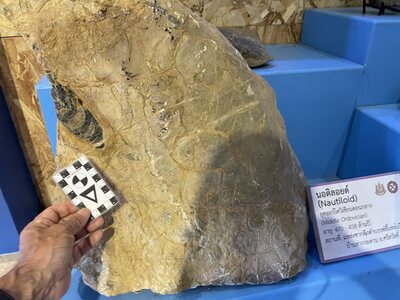 |
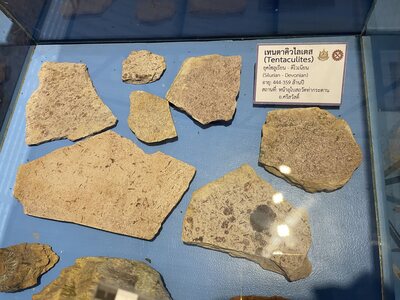 |
| こ
ちらがこの地域を有名にしている,オルドビス紀の直角貝(Nautiloid)です.一応英語の表記もあるので助かります.この石は丸い網目状の模様があ
るのをごらんになれると思います.これはあとで実際の露頭写真をお見せしますが,ストロマトライトだと説明していました.ただこの意見には反対論もあっ
て,それは2日目の報告でご説明します.
This is the Nautiloid of Ordovician age, which makes this area famous. The English description is also helpful. You can see the rounded reticular pattern on this stone. I will show you a photograph of an actual outcrop later, but he explained that it is stromatolite. However, there were objections to this opinion, which I will explain in the below column on the second day. |
こ
ちらもオルドビス紀の有名な化石で,テンタキュライトと言います.日本ではほとんど知られていない化石ですが,オルドビス紀の主要な示準化石の一つです.
こちらの地域では大きさがかなり小さいのですが,2008年にノルウエイのオスロで見た,同じ種類(ただし時代が一つ若いシルル紀のもの)はこれより大き
かったのを思い出します.オスロの同種の化石と思われるものの産地の写真は以下です.http://yossi-okamoto.net/.../7-8_Aug_Paleo/p1140635.jpg オスロの古生層の巡検の様子は下記からごらんになれます.http://yossi-okamoto.net/.../Futen/2008_Norway/Oslo_3.html
This is another famous Ordovician fossil called Tentaculite. It is one of the major Ordovician index fossils, although it is almost unknown in Japan. It is quite small in size in this area, but I remember seeing the same type (but from the Silurian, more younger era) in Oslo, Norway, in 2008, which was larger than this. Here is a photo of the locality of the supposed fossil of the same species in Oslo: http://yossi-okamoto.net/.../7-8_Aug_Paleo/p1140635.jpg A tour of the Oslo paleosols can be seen at: http://yossi-okamoto.net/.../Futen/2008_Norway/Oslo_3.html |
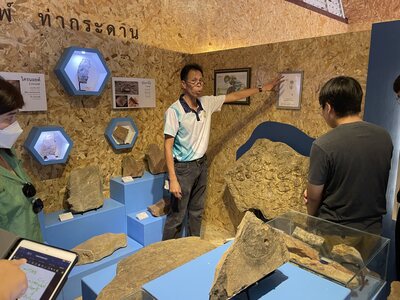 |
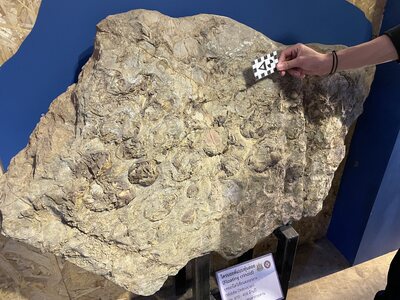 |
| さてもう一つ,この博物館自慢の標本の説明です.残念ながらタイ語でしたが.
Now, here is another explanation of the museum's prized specimens. Unfortunately, it was in Thai. |
こちらがそれで,海中に浮く種類のクリノイド(海百合)だそうで,東南アジアでは初めての発見と言っていたように記憶します.この化石は有名な六文銭のような断面の茎の部分ではなく,フロートを形成していた丸い部分だそうです.
This is a crinoid that floats in the sea, and I seem to remember that this is the first discovery of this kind in Southeast Asia. This fossil is not the stem part of the famous sextant, but the round part that formed the float. |
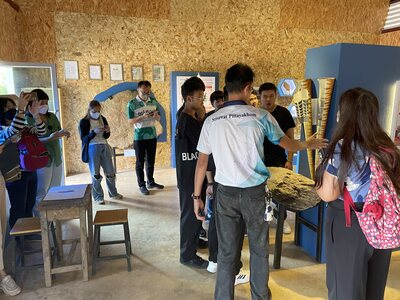 |
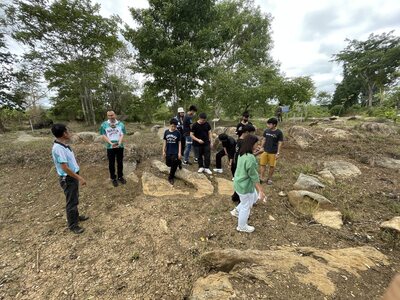 |
| 直
角貝のわかりやすい模型で説明があります.ここで少し生徒にアンモナイトなどの頭足類委と巻貝(Snail)の違いについて私が補足説明しました.要する
に貝の中が浮き沈みするための空洞か,身が詰まっているかの違いですね.生徒は熱心に聞いています.今回は男子生徒ばかりでした.
A simple model of a Nauiloid is used for explanation. Here, I explained to the students the difference between cephalopods such as ammonites and snails. In short, the difference is whether the inside of the shell is hollow for floating and sinking, or whether it is filled with body. The students listened attentively. This time, all the students were boys. |
さてさきほどの博物館から少し車で走ったところにある.直角貝の化石が見られる露頭です.露頭と言っても広大な空き地に石灰岩の風化で残った岩石が点在します.左の人の足元付近に網目状の模様があるのが見えるでしょうか?
Now, a short drive from the museum, there is an outcrop where you can find fossils of Nauitiloids. The outcrop is a vast open area dotted with rocks left by weathering of limestone. Can you see the reticulated pattern near the feet of the person on the left? |
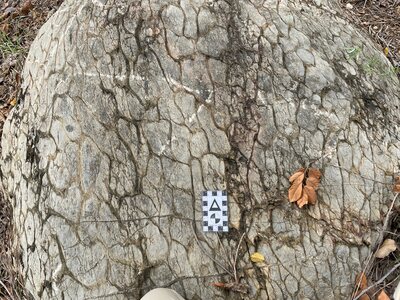 |
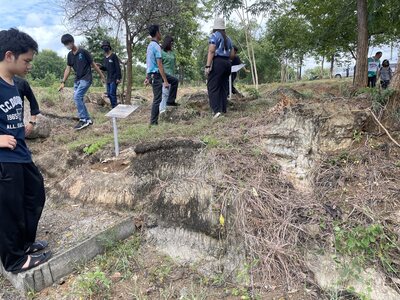 |
| これがそうです.博物館のスタッフはこれがストロマトライトだと言っていました.私の第一印象はずいぶん,知っているものとは様子が異なるストロマトライトだを思いました.これについては前述したように,2日目の報告で再度扱います.時代はオルドビス紀の石灰岩です.
This is it. The museum staff said this is a kind of stromatolite. My first impression was that it was a very different stromatolite from what I knew. As I mentioned above, I will deal with this again in my report on the second day. The age is Ordovician limestone. |
このように少し層をなしている場所もあります.これから層理面がわかりそうですが,水平から少し傾いているようです.見学地になっているようで,いくつか説明の看板があります.
In some places, there are a few layers as shown here. The stratigraphic plane can be seen from here, but it seems to be slightly tilted from the horizontal. There are some explanatory signs. |
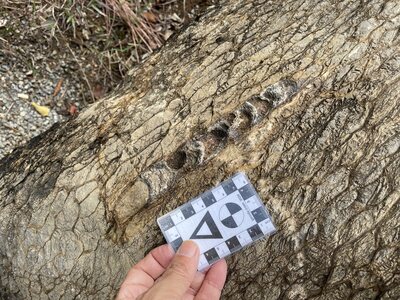 |
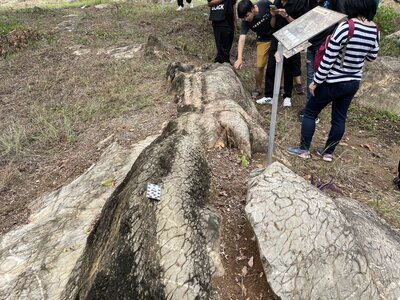 |
| こちらが典型的な直角貝の縦断面です.アンモナイトと同じように空気の入る隔壁構造がわかると思います.
Here is a typical longitudinal section of a Nautiloid. You can see the air-entraining septum structure, similar to that of ammonites. |
ほかの場所ではこのように層理らしいものが見えます.ゆるやかに右に傾斜してますね.現地での方向の確認を忘れました.
In other places, you can see what seems to be a bedding structure. The stratum is gently dipping to the right. I forgot to check the direction at the site. |
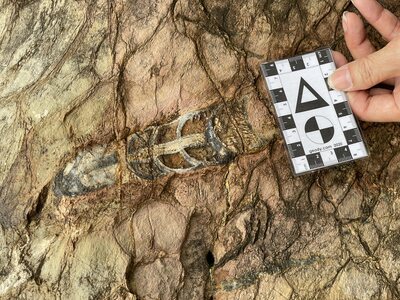 |
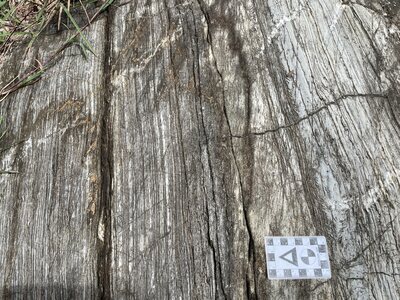 |
| なかなか見事な直角貝の化石の縦断面で,空気室と隔壁が見れます.周囲は例の「ストロマトライト」状の石灰岩.ただストロマトライト特有の内部構造はよく見えない.
This is a rather nice longitudinal section of a Nautiloid fossil, showing the air chamber and the septum. Surrounded by the "stromatolite" limestone. However, the internal structure unique to stromatolites is not clearly visible. |
こちらは一連の石灰岩層の下部にあたる部分で顕著なラミナが見られる.友人のB氏がみたら喜びそうな場所.
The lower part of a series of limestone layers shows a pronounced lamina. This is a place that my friend Dr. B would be pleased to see. |
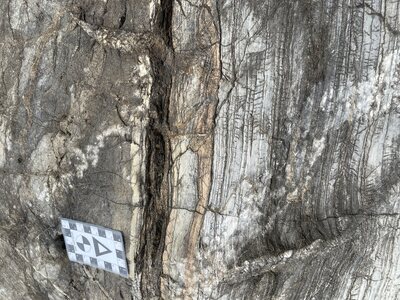 |
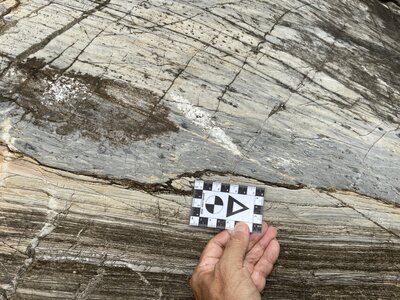 |
| と
きおりこのような上部に向けた吹き出し跡や,次の写真のようなタービダイトみたいな構造が見れる.次の巡検記その2で紹介する,マヒドン大学地質学教室で
放散虫を中心とする古生物学を研究されているS先生は,やや深い場所(陸だなの下部)の堆積で水流の跡も当然あるはずとのことだった.
Occasionally, we can see such upper sandpipe-like structures and turbidite-like structures as shown in the next picture. Dr. S, a researcher of paleontology focusing on radiolarians at the Department of Geology, Mahidol University, who will be introduced in the below, Part 2, said that there should be traces of water flow in the slightly deeper part of the deposit (the lower part of the land shelf). |
これが興味深い構造で,あきらかに上部の層は下部層を削り込んでいる.上部層の一番下(灰色の部分)は細かい化石の破片などを含んでいるので,乱泥流堆積物ではと想像している.Bさん間違っていたら訂正してください.
This is an interesting structure, and clearly the upper layer is cutting into the lower layer. The bottom part of the upper layer (gray area) contains fine fossil fragments, so I imagine that it is a turbulent mudflow (limestone composit) deposit. |
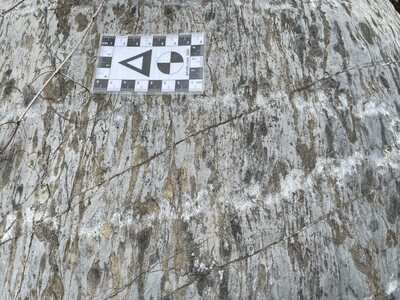 |
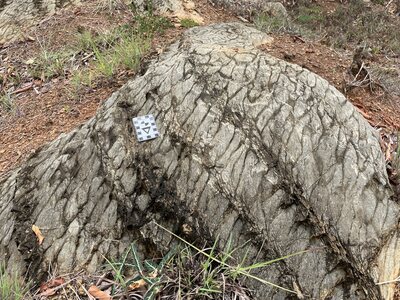 |
| これもなかなか微妙な堆積物.どちらが上かは忘れました.
This is also a very delicate deposit. I don't remember which is the upper side. |
さらに下部には再び網状部分が出てくる.
The reticulation appears again at the bottom. |
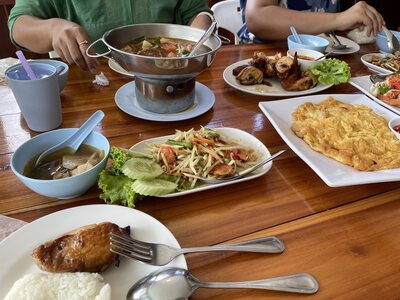 |
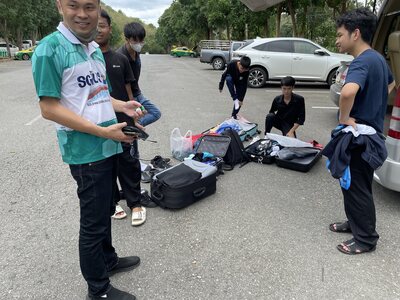 |
| と
いうことで午前の巡検は終了して,有名な7連滝がある近くのレストランで生徒たちと昼食.この巡検には私の世話をしていただいている,Silpkorn大
学理学部のSciUS組織の校長にあたるDr.L先生と自然地理学専攻のDr.A先生,それにSciUSのスタッフの女性が3人同行してくれた.あと男の
先生も生徒の面倒を見るために来られていた.
The morning excursion ended with lunch with the students at a restaurant near the famous 7 waterfalls. I was accompanied by my caretakers, Dr. L sensei., the head of the SciUS organization in the Faculty of Science at Silpkorn University, Dr. A sensei, a professor in the Department of Natural Geography, and three SciUS staff members. A male teacher also came to take care of the boy students. |
さて生徒は何をしているかというと,荷物の中から滝で泳ぐための水着を取り出しています.下のコメントでDr.L先生が笑ってコメントをくれています.
The students are taking out their swimsuits from their luggage to swim in the waterfall. Dr. L. sensei is laughing and commenting below (in my FB). |
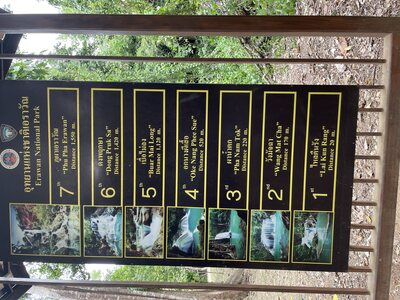 |
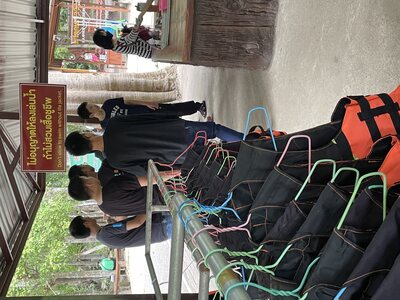 |
| 海水パンツを用意してこの7連の滝の遊歩道を登ります.いずれもなかなか美しい滝です.あとでわかるのですがいずれも石灰岩の侵食でできたものです.鍾乳洞にある皿の模様の段ができるのにも少し似ているなと感じました.
Prepare our swimming trunks and climb up the trail of this series of seven waterfalls. All of them are quite beautiful. As I found out later, they are all formed by the erosion of limestone. I thought it was similar to the dish pattern in limestone caves. |
滝つぼで泳ぐ場合はかならずここでライフジャケットを借りて着用しないといけないのです.私は昼食時のドライブインの土産物やで水着を80バーツで購入していたので,それを着ました.
f you want to swim in the waterfall, you must rent a life jacket and put it on. I had bought a swimsuit for 80 baht at a souvenir shop at the drive-in during lunch time, so I wore it. |
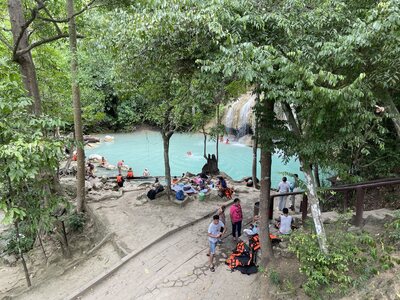 |
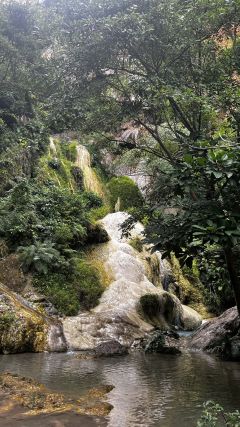 |
| 7
番目の滝まで上った山から下りてきて,この3番目の滝の滝つぼで泳ぎました.付き添いの先生たちはみんな遠慮していましたが,私は怖いもの知らずなので,
生徒と一緒に泳ぎました.もちろんライフジャケットを着たまま得意のバタフライを披露しました.-----実はこれ後日談があって,この次の日に筑波大を
退官されてこちらの大学で教えておられるS先生と夕食を食べたのですが,その時にタイの淡水では泳がない方がよいと誰かにアドバイスされたという話を伺い
ました.理由は未知の菌がいると危ないからだそうです.温泉のように50℃を越えていればよいそうです.海水は問題ないそうです.---それからかれこれ
数日経って,私は特に身体は異常がでてはいません.
We came down from the mountain after climbing to the seventh waterfall and swam in the basin of this third waterfall. All the teachers were reserved, but I was not afraid, so I swam with boys. Of course, I showed them how to do the butterfly with my life jacket on. I had dinner the next day with Dr. S, who retired from the University of Tsukuba and is now teaching at Mahidol University here. He said that we Japanese had not better to swim in the flesh water in Thailand. The reason is that it is dangerous to swim in freshwater because of the presence of unknown bacteria. Also, he said that it is OK as long as the temperature is above 50 degrees Celsius, like in a hot spring. Seawater is not a problem. ---I have not had any physical problems in the past few days. |
7
人の生徒のうちの一人がスマホを持っていたので,最後の7番目の滝の写真を撮ってもらいました.滝の表面は鍾乳洞の鍾乳石ような白い石灰質のカバーで覆わ
れています.このあと実は欧米系の若い男2名がこの滝の左側の崖を登りかけて,監視員に見つかって笛を吹いて降ろされていました.タイは結構環境保全にう
るさい国です.次の写真でも紹介します.
One of the seven students had a smartphone, so I asked him to take a picture of the seventh and final waterfall. The surface of the waterfall is covered with a white calcareous cover, like stalactites in a limestone cave. After this, two young men of Western descent actually tried to climb up the cliff on the left side of this waterfall, but the warden found them and whistled them down. Thailand is a country that is quite concerned about environmental conservation. The following photos will be shown in the next section. |
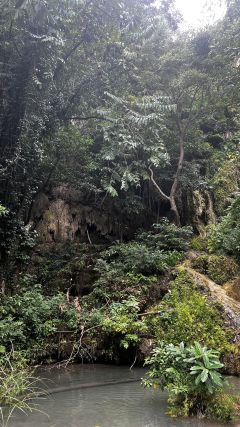 |
 |
| さ
らにこの滝の左側の部分には鍾乳石のような構造が見れます.どうも巨大な鍾乳洞がシンクホールになって壊れたのではないかと想像しています.私がスマホを
持っていなかったのは,途中に関所があってそこで,ペットボトルは全部保管されました.タイ政府のポリシーで環境に悪いものを,このような環境を保全する
場よに持ち込まさないようにしているのです.違反して見つかると2000バーツの罰金と書かれていました.
In addition, a stalactite-like structure can be seen on the left side of the waterfall. I imagine that a huge stalactite cave must have been broken by a sinkhole. The only reason I did not have my phone with me was that there was a gate on the way and all the plastic bottles were kept there. It is the policy of the Thai government not to allow environmentally harmful items to be brought into an environmentally protected place such as this. If you are found violating this policy, you will be fined 2,000 baht. |
さてこの日の最後の露頭は,観光地の滝に入る;国道からの入口の左側にありました.文献にはカンブリア紀の砂岩(クオーツアイト)とあります.
Now the last outcrop of the day was on the left side of the entrance from the national road; into the tourist waterfall. The literature says it is a Cambrian sandstone (quartzite). |
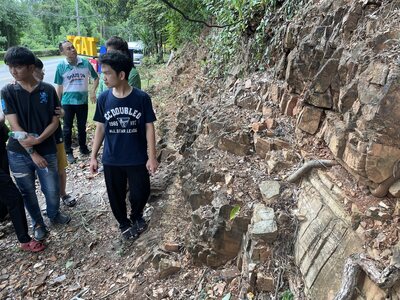 |
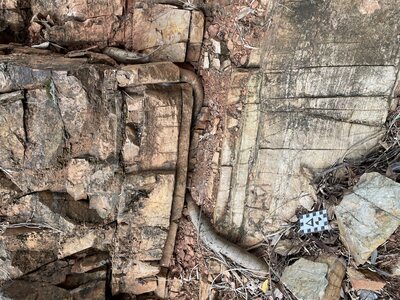 |
| 滝のあたりの石灰岩とは異なり,結構しっかりした砂岩層です.ここでゲートの人に断って少しだけハンマーを使い生徒にみせました.
Unlike the limestone around the waterfall, this sandstone layer is quite solid. I showed the students how to use a hammer to get a better view of the sandstone, after a permission by the gatekeeper. |
砂岩に若干の圧力と熱が加わって,クオーツアイトになっているようです.少しラミナのようなものが残っています.
The sandstone seems to have become quartzite due to some pressure and heat. There is a little lamina-like residue. |
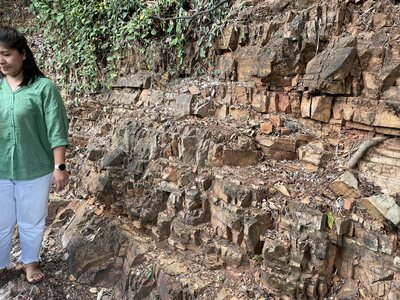 |
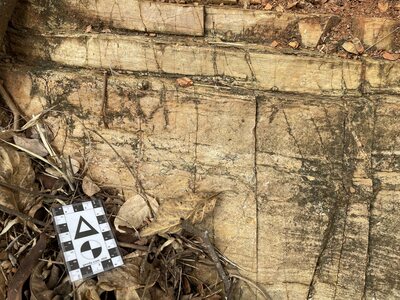 |
| いつも世話をしていただいている化学専門のDr.L先生です.地質はからっきしだめと言われたいましたが,結構興味深そうにおつきあいいただきました.
This is Dr. L., sensei, a chemistry specialist who always takes care of us. She told me that she is not good at geology, but she seemed to be very interested in the field. |
もう一枚露頭写真です.ラミナが見えています.ここでは並行ラミナのようです.これにて1日目の巡検報告を終了します.いずれまた2日目をつづります.こうご期待.
Another close-up photo. The lamina is visible. The lamina appears to be a parallel lamina. This concludes the inspection report for the first day. We will continue with the second day. Stay tuned. |
続いて2日め.Mahidol大学地質学部の見学と野外巡検.
The second day was spent visiting the Department of Geology at Mahidol University and making a field trip.
<It is already the second day of our stay in Chiang Mai, the ancient capital of northern Thailand. Today, I gave a talk on geology to third-year high school students here. Unfortunately, the arrangements were not so good that we could not observe the rock garden outside the geology department (09/07. We were able to observe the rock garden later on). Here is a report on the second day of my stay in Kanchanaburi.
We stayed at the dormitory of the Kanchanaburi campus of Mahidol University. In the evening, I met Dr. S, a retired professor of University of Tsukuba, who was invited from Japan. He has published many papers on radiolarian research in Thailand. He is a very gentle and calm person, just as I imagined. I was very happy to be able to drink delicious Chang beer with such an amazing professor while watching the sunset on the Mekong River. Now, let me introduce you with some photos.
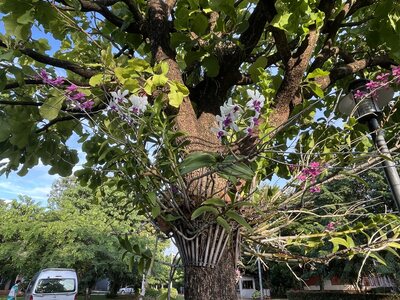 |
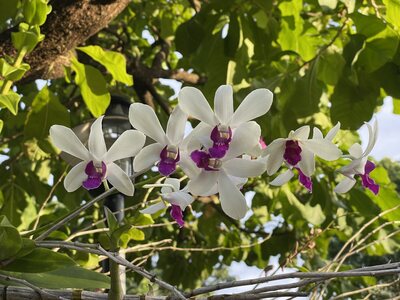 |
| マ
ヒドン大学はバンコク市内が本キャンパスなのですが,このカンチャナブリの山の中にも別のキャンパスがあるのを今回初めて知りました.しかもここに大学が
建ったのは多分に地質学教室がここを本拠にしたいと主張したからとも聞きました.ただし現在は地質学部のほか,環境関連とかいくつかの学部がここにありま
す.キャンパスの大半は森に覆われているといっても過言ではない田舎です.これは敷地内の宿舎の前に咲いていた蘭ですね.
The main campus of Mahidol University is in Bangkok, but I learned for the first time that there is another campus in the mountains of Kanchanaburi. I also heard that the university was built here because the Department of Geology insisted on using it as its headquarters. However, there are now several environmental and other departments in addition to the Department of Geology. Most of the campus is covered with forest in the countryside, which is no exaggeration. This is an orchid blooming in front of the dormitory on the campus. |
花はカトレアに似るが,おそらくデンファレ系の品種.派手な色と大きな花弁はおそらく園芸種だろうと想像される.
The flowers resemble those of Cattleya, but are probably of the Denfale type. The showy color and large petals suggest that it is probably a garden variety. |
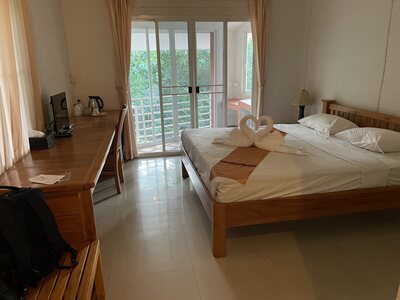
|
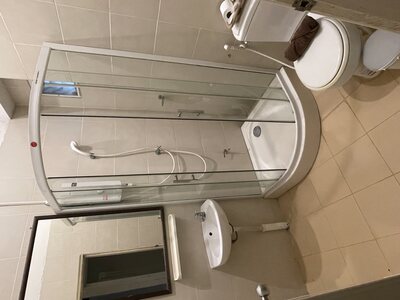
|
| 大学敷地内とは思えないほど立派な宿舎で驚きました.もちろんエアコンも新しくよく効きます.
I was surprised at how magnificent the dormitory was, which I could not believe it was on the university's premises. Of course, the air conditioner is new and works well. |
シャワー室はこんな感じで,なんとも高級ホテルのイメージで驚きました.久しぶりに熱いシャワーを浴びることができました.
I was surprised to see a shower room like this, which was the image of a luxury hotel. It had been a while since I had a hot shower. |
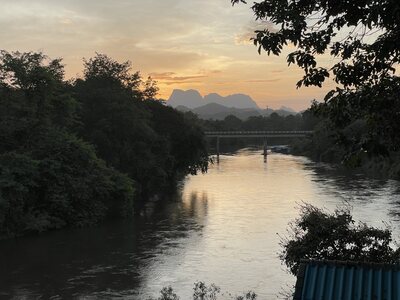
|
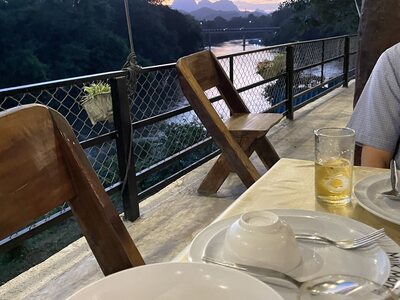
|
| さ
て部屋に荷物を置いて夕食を食べにクワイ河沿いのレストランに移動しました.車で10分ほどの列車の駅がある,小さな町のはずれにあります.この夕焼けが
良かった.なんか絵画の舞台のような素晴らしい夕焼けでした.カルストで形成された起伏が激しい山の借景もいいですね.註.クワイ河は日本語での表記で
す.詳しくは下記をどうぞ.https://web-gis.jp/GS.../GeoDocument/GeoSite_W05-043.html
We left our luggage in the room and moved to a restaurant along the Kwai River side for dinner. It is located on the edge of a small town with a train station about 10 minutes away by car. The sunset was beautiful. It was like a stage for a painting. The view of the rugged mountains formed by karst is also nice. Note. Kwai River is the Japanese name for the river. For more information, please visit: https://web-gis.jp/GS.../GeoDocument/GeoSite_W05-043.html |
さてこの素晴らしい風景のレストランで初めて対面させていただく,S先生とビールを飲みながら日本語で地質の話ができた至福の時でした.2週間以上に及ぶ英語遣いの生活から解放されました. It was a great pleasure to talk about geology in Japanese over a beer with Dr. S sensei, who I met for the first time in a restaurant with such a wonderful view, and I was released from more than two weeks of English speaking life. |
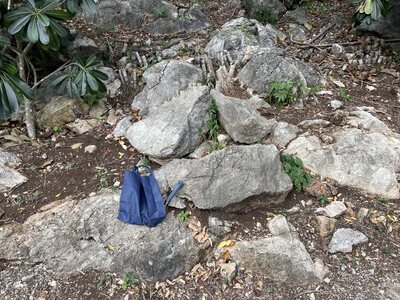 |
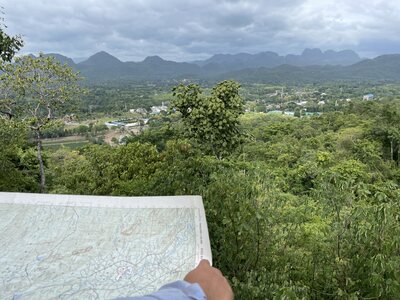 |
| さ
て翌日朝食を取ったあと,早速目を付けていた宿舎敷地内の石灰岩を調べます.これがなかなか化石が見つからない.あとでわかったのですが,なんとこれはペ
ルム紀ではなくトリアス紀のものだったようで,おまけにドロマイトなので化石が少ないとあとで聞きました.みかけはとても良さそうな石灰岩で期待していた
のですが.
The next day, after breakfast, I went to examine the limestone rocks on the grounds of the lodge, which I had been eyeing. It was not easy to find fossils. I found out later that the limestone was not from the Permian but from the Triassic period, and that there are few fossils because it is dolomite. It looked like a nice limestone and I had high hopes for it. |
S先生のお弟子さんのPさん(後述)が,地図を持ってきてビューポイントで地形の説明をしてくれました.遠くに見えるギザギザの山塊が石灰岩でできていて,ギザギザしているという説明です.
Dr. P, a student of Dr. S sensei (see below), brought a map and explained the topography at the view point. He explained that the jagged mountains seen in the distance are made of limestone and have jagged edges. |
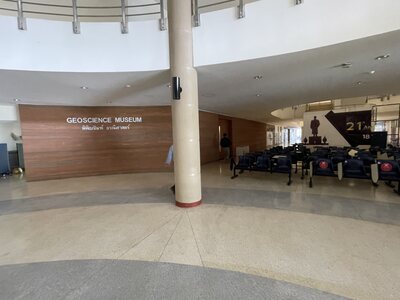
|
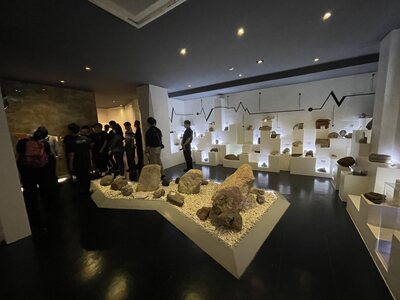
|
| さてこの日の見学はマヒドン大学地質学部の地質博物館の見学です.立派な地質学部棟の中にあります.
The tour of the day was a visit to the Geology Museum of the Faculty of Geology, Mahidol University. The museum is located in the magnificent building of the Faculty of Geology. |
生
徒7名付き添いの教員4名+スタッフに話をしてくれたのは,この大学でS先生の教え子で共同研究者のPさんと,秋田大学の鉱山学部でPhDを取ったAさん
の2人のスタッフです.いずれも私のタイでの知り合いの,チュラ大を退職されたP先生とも縁の深い方たちです.Pさんは有孔虫を中心とした古生物学,Aさ
んは火成岩などの岩石学が専門です.
The seven students and four accompanying faculty members plus staff members were talked to by two staff members: Dr. P sensei, a student and collaborator of Dr. S sensei, and Dr. E senesi, was a PhD student at the School of Mines, Akita University. Dr. P sensei is a paleontologist specializing in foraminifera, and Dr. E sensei is a petrologist specializing in igneous rocks. |
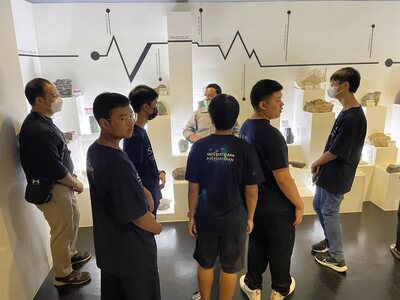
|
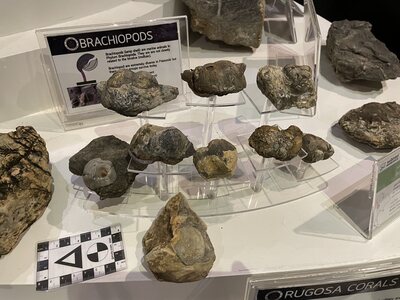
|
| 奥のPさんと左のAさんが,かわるがわる展示された岩石を説明するのですが,これが結構難しい内容で,大学教養から専門課程のような話でした.私にはとても興味深かったのですが,今一つ地学の知識の少ない生徒には,どうだったかはよくわかりません.
Dr. P in the back and Dr. E on the left took turns explaining the rocks on display. It was very interesting for me, but I am not sure how it would have been for students with less knowledge of geology. |
椀足貝だけでも,たくさんあって,どれもとれも素晴らしいコレクションです. There are many Brachiopods alone, and each one is a wonderful collection in its own right. |
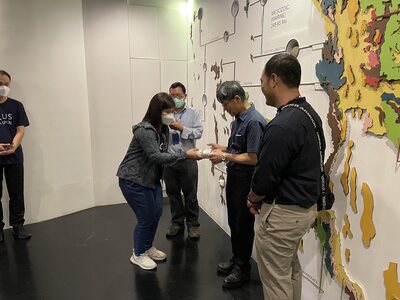
|
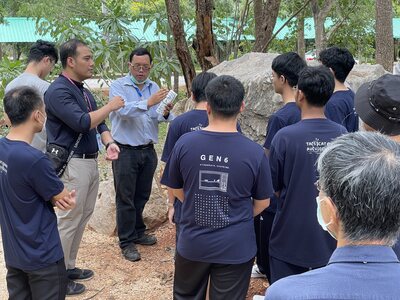
|
| 昼
食時に,今回の巡検を企画してくれたSilpakorn大学のLooknum先生から,お世話になった3人の方にお礼をお渡ししています.今渡されている
方がSashida先生です.この9月末でこちらを定年退職されるそうで,よいタイミングで見学のお願いができたと思っています.ちなみに昼食時にAさん
とPさんから来年1月にこのキャンパスで地質の国際学会が開かれるのを初めて知らされました.乗りかかった船で参加を申し込むことにしました.12月末に
別の日本のさる学会主催の地質巡検がタイ南部であって,それに申し込んでいた私は,この学会に参加することで,懸案のS大学へ贈呈した地震計の修理もその
間で行えるという,素晴らしいプランが建ちました.またタイを再訪できるのもうれしい限りです.
At lunch time, Dr. Looknum of Silpakorn University, who organized this field trip, handed out thank-you cards to the three people who helped us. The one who is handing now is Prof. Sashida. He is going to retire at the end of this September, and I think it was a good timing to ask him to visit us. Incidentally, during lunch, Dr. E san and Dr. P san informed me that an international conference on geology will be held at this campus in January next year. I had already signed up for a geological field trip to southern Thailand organized by another Japanese academic society at the end of December, and I had a great plan to attend the conference so that I could repair the seismograph that I had presented to Silpakorn University before the conference. I am also happy to be able to visit Thailand again. |
昼
食後はこちらの野外にある岩石園の展示を見て回ります.ここでもお2人の熱弁が続きます.主には私たちにもわかるように英語で,時にタイ語になって話が続
きます.手前でマスクをかけている後ろ姿の方がS先生です.しずかにお弟子さんたちの説明を聞かれていたのが,印象的でした.退職後の1月に,またこちら
で開催される学会でお会いすることを約束しました.
After lunch, we visited the rock garden in the campus. Here, too, the two speakers continue their passionate speeches. They spoke mainly in English, sometimes in Thai, so that we could understand them. The man in the back wearing a mask in the foreground is Prof. S sensei. It was impressive to see him calmly listening to the explanation of his students. We promised to meet again in January, after his retirement, at a conference to be held here. |
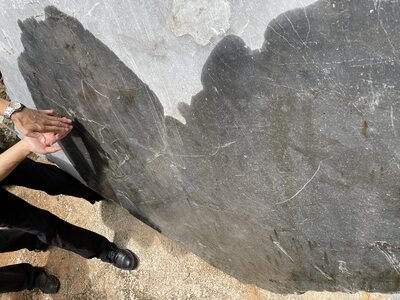
|
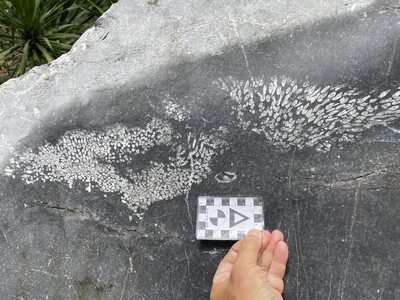
|
| フ
ズリナとサンゴを含むj巨大なカットされた岩石のところで,それまで静かに説明を聞いておられたS先生が,自ら英語で生徒に説明されました.私はここで気
がついて水のボトルを車に取りに行って戻ってきて,表面に水をかけて化石がみやすくしました.S先生に褒めていただきました.写真では難しいですが,フズ
リナの密集がきれいに見えます.
At the point of a huge cut rock containing fusulina and coral, Prof. S sensei, who had been quietly listening to their explanation, explained to the students in English himself. I noticed that I went to the car to get a bottle of water, came back and splashed water on the surface to make it easier to see the fossils, and Prof. S sensei praised me. It is difficult to see in the picture, but the dense Fusulina is beautiful. |
こちらは同じ石の上部にあるサンゴの密集です.水をかけて見え方がきれいになりました.手に持っているスケールは家でパウチを充てて作ってきて,生徒全員にプレゼントしました.写真を撮るときはかならず何かスケールを入れるようにと,アドバイスするためです.
This is a dense corals on the top of the same rock. The appearance was cleaned up by watering it. I made the scale at home and gave it to each student as a gift to advise them to always put something on the scale when they take a picture. |
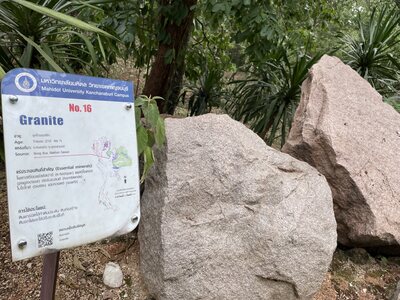
|
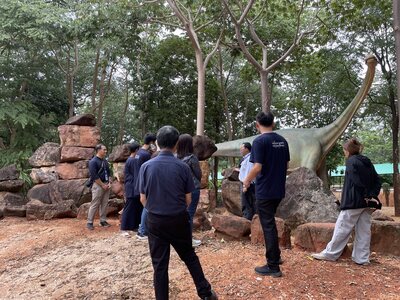
|
| 岩石園には40以上の番号のついた立て札と岩石があって,それぞれ見て回ればとても半日では収まらない規模です.それを重要な部分だけ回ったのですが,これで午前中はすべて時間を使いきりました.
There are more than 40 numbered plaques and rocks in the petrographic garden, which would take more than half a day to visit. I visited only the most important parts of the garden, which took up the entire morning. |
最後に近い見学場所で,ご存じコラート高原の恐竜の骨や足跡を含む地層の岩石(砂岩)の展示です.これらの展示された岩石はこの学部を作ったタイでは有名な地質学者の方が,協力事業を行っていたDMR(タイ地質調査所)から.ほとんどただでもらったものだそうです.
The last place to visit near the end of the rock garden is the display of rocks (sandstone) from the formation that contains the well-known dinosaur bones and footprints from the Korat Plateau. These rocks were given to the department by the DMR (Geological Survey of Thailand), a cooperative project of the famous Thai geologist who established the department, almost for free. They were given to him almost for free. |
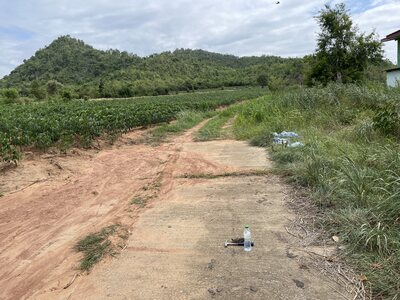
|
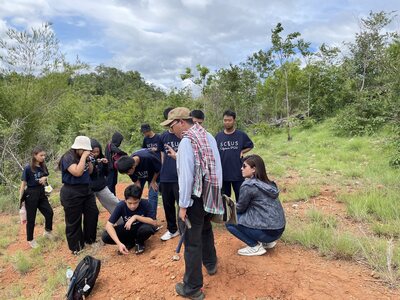
|
| さて大学のキャンティーン(学食)で昼食を取ったあと,仕事に戻られるS先生やAさんに礼を言って別れて,Pさんに連れられて廃校になった小学校まで来ました.グランドに車を停めて校舎の脇の道を少し歩きます.左に見えるのは一面キャッサバが植えられた畑です.
After having lunch at the university cafeteria, I thanked Prof. Sashida sensei and Dr. Earth who were going back to their work, and Dr. P san took us to the abandoned elementary school. We parked the car on the ground and walked along the side of the school building. On the left is a field with a cassava plantation all over. |
連れてこられた場所は赤い熱帯特有の風化土壌がある場所でしたが,聞くとPさんの研究のフィールドだそうです.この赤い砂岩(風化しているのでそのようには見えないが)と少し右奥にある石灰岩層から,ペルム紀の化石が出るそうです.
We were taken to a place with weathered soil characteristic of the red tropics, which I was told was the field of Dr. P's research. This red sandstone (which doesn't look like it because of the weathering) and the limestone layer a little to the right produce Permian fossils, I was told. |
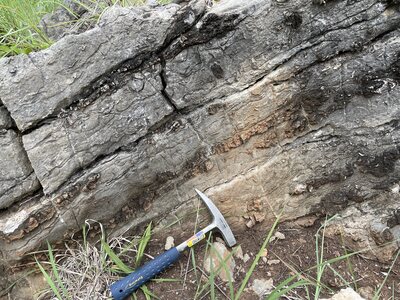
|
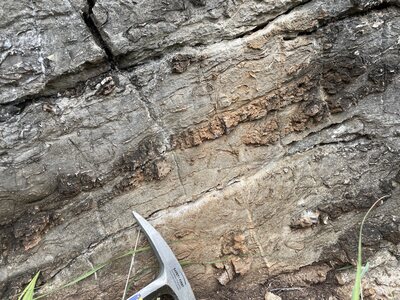
|
| こちらが石灰岩層の方です.確かに何か化石らしい模様が見えます.
This is the limestone layer. There is a fossil-like pattern. |
拡
大すると確かに2枚貝のような断面が見えるのですが,これは2枚貝ではなく,貝の断面が非対称のBrachinopod(腕足貝)だそうです.生徒にここ
でハンマーの使い方を教えて,私とPさんのハンマーを貸して生徒に石を割らせました.いくつかの貴重な化石を学校に持ち帰ることになりました.
When enlarged, the cross section looks like a bivalve shell, but this is not a bivalve shell, but a Brachinopod (brachiopod) with an asymmetrical cross section. I taught the students how to use a hammer here and let them use mine and Dr. P's hammers to break the stone. We brought some valuable fossils back to the school. |

|
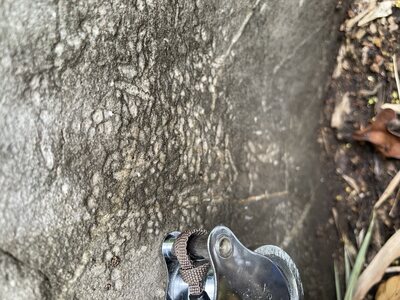
|
| これで終わりかと思ったら,小学校の校舎を回ったところにまたもう一か所ありました.何でもPさんの学部の卒論の場所だそうです.こちらも見事なフズリナの化石が見つかります.Pさんが生徒に図を書いて,フズリナの内部構造を説明しています.
I thought that was the end of it, but we found one more place around the elementary school building. This was the site of Dr. P's undergraduate thesis. Here, too, we find a magnificent fossil of Fusilina, and Dr. P san is drawing a diagram to explain the internal structure of Fusilina to our students. |
こちらがフズリナが密集した部分,ここでも私は水かけ係をさせてもらいました. Here is a dense part of fusurina, and here again I was assigned to water the plants. |
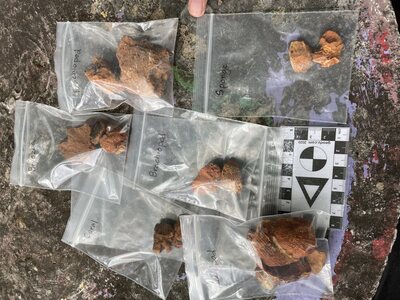
|
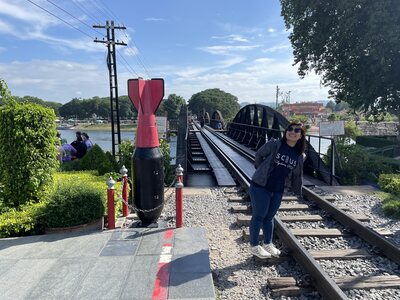
|
| さてやっと一連の見学と採集が終了し.Pさんがさきほどの砂岩の部分を中心に多様な化石を採集して,ビニール袋に化石名を記入して,学校に寄付してくれました. Finally, after a series of visits and collecting, Dr. P san collected a variety of fossils, mainly from the sandstone area mentioned earlier, wrote the names of the fossils on plastic bags, and donated them to the school. |
さ
てこの日最後の行先は,カンチャナブリといえばここを忘れてはいけない.日本人にとっても戦争中の歴史を思い起こす重要な場所「クワイ河鉄橋」です.小学
校のときに学校から映画鑑賞で「戦場にかける橋」を見に行ったのを思い出します.このときのテーマ曲「クワイ河マーチ」は小学校の担任の先生が音楽の先生
で,生徒の楽団を作って演奏会に出たのですが,そのとき誰も弾きてのいなかったコントラバスを私がひかされて,連日の練習で右手の指がタコになっていたの
を思い出します.画面のL先生には本当に巡検を含めて滞在中にお世話になりました.
The last destination of the day was the "Kwai River Bridge", which is an important place for Japanese to remember the history of Kanchanaburi during the WWII. I remember going to see the movie "Bridge over the River Kwai" when I was in elementary school. My homeroom teacher at that school was a music teacher, and we formed a student orchestra to perform the theme song "March on the River Kwai" at a concert. I really appreciate all the help I received from Dr. Looknum Sensei of the screen during my stay, including thid field trips. |
>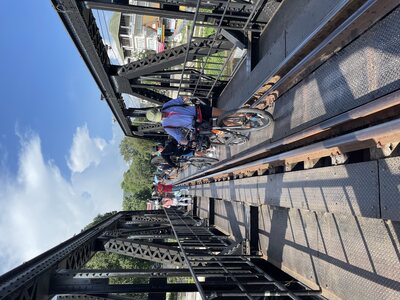
|

|
| このクワイ河鉄橋を歩いて渡ります.かなりの川幅で向こうまで渡りましたが,向こう側にはあまり店も少ないので,また歩いて帰ってきました.川のこちら側が観光地として賑わっているようです.
We walked across the Kwai River Bridge. The width of the river is quite wide and we crossed to the other side, but there are not many stores on the other side, so we walked back home again. This side of the river seems to be more crowded as a tourist spot. |
橋を往復して帰ろうと思ったら,先生たちは何かを待っています.何を待っているのか
と思ったら,なんと列車のとおる時刻だったのです.貴重な体験をさせてもらいました.動画は橋をゆっくりと渡っていた電車.私の前で写真を取っていた南欧
系の2人の観光客が線路に立ち入ったので,電車が止まって運転手に怒られたところから,動画はスタートします.ということで,滝での水泳と最後の電車以外
は,地質見学に明け暮れた私には素晴らしい旅行でしたが,生徒や付き添いの先生が感動したかどうかはわかりません.これでカンチャナブリ日記を完としま
す.
After returning to the bridge and back, the teachers were waiting for something. I wondered what they were waiting for, but it turned out to be the time for the train to come. It was a precious experience for me. The video shows a train slowly crossing the bridge. The video starts with two tourists from southern Europe who were taking pictures in front of me, and they stepped onto the tracks, so the train stopped and the driver got angry with them. So, other than swimming in the waterfall and the last train ride, it was a great trip for me, but I don't know if the students and teachers were impressed or not. This concludes my Kanchanaburi Diary. |
Copyright © 2023 Yoshio Okamoto All Rights Reserved.